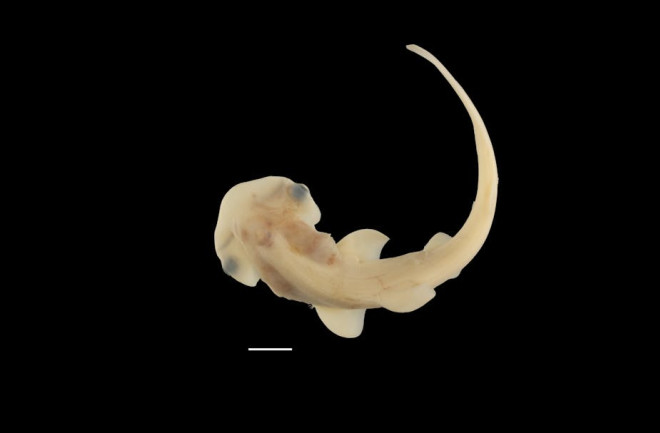Scientists very rarely get access to most sharks, the development of their young or the nursery grounds where they grow. So seeing a hammerhead shark(Sphyrna tiburo) embryo, halfway through its five-month development, is very unusual.
Access to growing embryos is key for developmental biologists like me as we try to understand the diversity of animals on Earth. Usually the fishes I study, including other shark species, lay eggs, which allows us to easily watch development in real time.
Hammerhead sharks don’t lay eggs, though. They gestate their pups in utero. A pregnant shark carries up to 16 embryos, each nourished by an umbilical cord, just like human embryos are. Then the mother gives birth to live young, and these babies are self-sufficient with teeth and jaws, ready to survive on their own.
Access to a hammerhead embryo is very rare, which is what makes this image so special.
Access To A Very Rare Resource
In order to make this image, my colleagues and I salvaged embryos from adult female sharks that had been caught as part of population surveys off both the Gulf and Atlantic coasts of Florida. Usually these sharks are tagged and released. But a small number die during this process and are then studied for insights about diet, age, growth, reproduction and toxicology. No sharks were sacrificed just for our study. The embryos would have otherwise been wasted when the mothers died.
For this work, Steven Byrum, a graduate student in my lab, was able to document the entire set of developmental stages using a total of 177 bonnethead shark embryos.
We were able to assemble a kind of visual growth chart, from the earliest embryos – they look nothing like hammerheads – to the specific point in development when the hammerhead takes shape, through the rest of development before birth. No scientists had ever before charted the development of hammerhead sharks in this way.
This research allows us to study crucial stages in hammerhead development and, importantly, the precise moments – like this one pictured – when the embryo develops the characteristic head shape.
Adding To What’s Known About Hammerheads
Hammerheads are a peculiar group of only eight species of sharks that uniquely develop a hammer-shaped head known as a cephalofoil, named for its hydrodynamic design used for quick turns and pinning down prey. This particular species is known as the bonnethead because of its relatively small, rounded “hammer.”
Scientists think the wide, flattened head shape with eyes on each side evolved to enhance the animals’ senses. Wide positioning of the eyes allows for an increased field of vision, and wide, expanded nasal capsules provide enhanced olfactory capability.
The hammer-shaped heads are covered with expanded electric detector organs that support the sharks’ “sixth sense.” They can detect even the smallest electrical signals, such as the pulses from a prey fish’s heartbeat, or the Earth’s magnetic fields, which they can use to navigate during migration.
Access to these amazing shark pup embryos allows us to compare their development with other regular-headed sharks and ask how and why hammerheads grow these wonderful noggins.
The ocean hides a wealth of weird and wonderful fishes, most of which are inaccessible, and studies of their development are impossible. My lab continues to uncover insights into the evolution of life on Earth thanks to these fortuitous opportunities.
Gareth J. Fraser is an Associate Professor of Evolutionary Developmental Biology at the University of Florida. This article is republished from The Conversation under a Creative Commons license. Read the original article.
